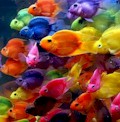The solute content of water is perhaps the most important aspect of water conditions, as total dissolved solids and other constituents can dramatically impact basic water chemistry, and therefore how organisms are able to interact with their environment. Salt content, or salinity, is the most basic classification of water conditions. An aquarium may have fresh water (salinity below 0.5 parts per million), simulating a lake or river environment; brackish water (a salt level of 0.5 to 30 parts per million), simulating environments lying between fresh and salt, such as estuaries; and salt water or sea water (a salt level of 30 to 40 parts per million), simulating the ocean or sea environment. Rarely, even higher salt concentrations are maintained in specialized tanks for raising brine organisms.
Several other water characteristics result from dissolved contents of the water, and are important to the simulation of natural environments. Saltwater is typically alkaline, while the pH (alkalinity or acidity) of fresh water varies more. Hardness measures overall dissolved mineral content; hard or soft water may be preferred. Hard water is usually alkaline while soft water is usually neutral to acidic. Dissolved organic content and dissolved gasses content are also important factors.
Home aquarist’s typically use modified tap water supplies through the local water supply network to fill their tanks. Because of the chlorine used to disinfect water supplies for human consumption, straight tap water cannot be used. In the past, it was possible to “condition” the water by simply letting the water stand for a day or two, which allows the chlorine time to dissipate.
More sophisticated aquarist may make other modifications to their base water source to modify the water’s alkalinity, hardness, or dissolved content of organics and gasses, before adding it to their aquaria. This can be accomplished by a range of different additives such as sodium bicarbonate to raise pH. Some aquarist will even filter or purify their water prior to adding it to their aquarium. There are two processes used for that: deionization or reverse osmosis.
The temperature of the water forms the basis of one of the two most basic aquarium classifications: tropical vs. cold water. Most fish and plant species tolerate only a limited range of water temperature. Tropical or warm water aquaria, within an average temperature of about 25 degrees C (77 degrees F), are much more common and tropical fish are among the most popular aquarium denizens. Cold-water aquaria are those with temperatures below what would be considered tropical; some varieties of fish are better suited to this cooler environment. More important than the temperature range itself is the consistency in temperature; most organisms are not accustomed to sudden changes in temperature, which could cause shock and lead to disease. Water temperature can be regulated with a combines thermostat and heater unit (or more rarely, with a cooling unit).
Water movement can also be important in accurately simulating a natural ecosystem. Aquarist may prefer anything from still water to swift simulated currents in an aquarium, depending on the conditions best suited for the aquarium's inhabitants. Water movement can be controlled through the use of aeration from air pumps, powerheads, and careful design of internal water flow.
Aquarium Nitrogen CycleOf primary concern to the aquarist management is the biological waste produced by an aquarium's inhabitants. Fish, invertebrates, fungi, and some bacteria excrete nitrogen waste in the form of ammonia (which will convert to ammonium, in acidic water) and must then pass through the nitrogen cycle. Ammonia is also produced through the decomposition of plant and animal matter, including fecal matter and other detritus. Nitrogen waste products become toxic to fish and other aquarium inhabitants at high concentration.
